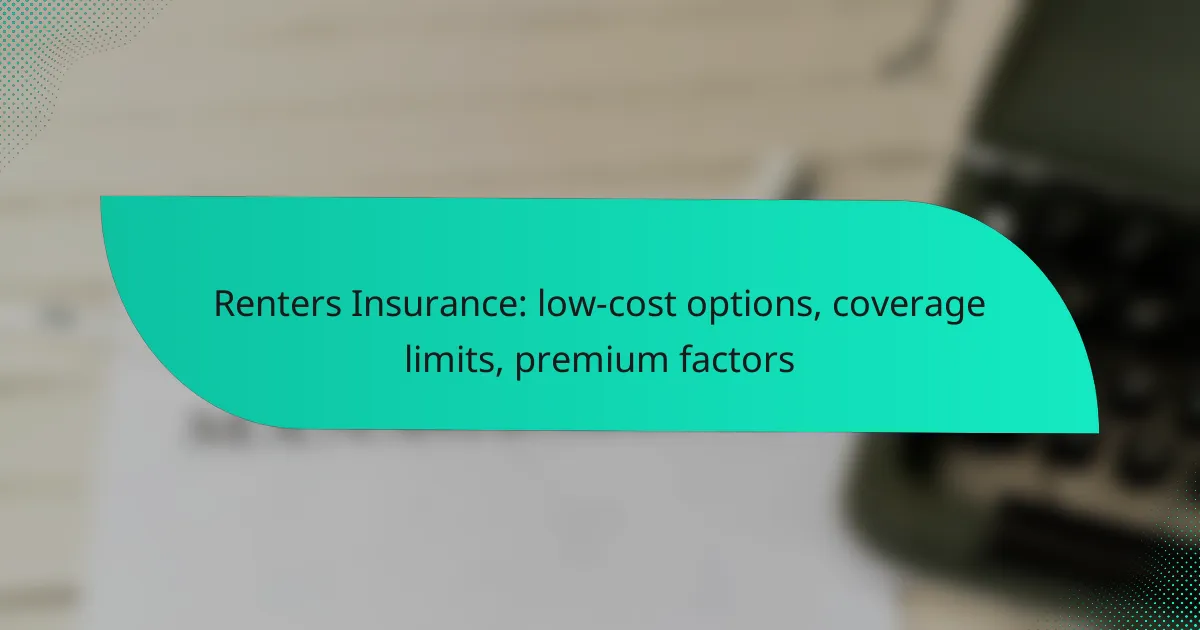Renters insurance is an essential safeguard for those renting a home, offering protection for personal belongings and liability. Many low-cost options are available from providers like Geico, State Farm, and Progressive, which cater to budget-conscious renters while providing essential coverage. It’s important to understand coverage limits and how various factors, such as location and credit score, can influence premiums to find the best policy for your needs.

What are the best low-cost renters insurance options in the US?
Some of the best low-cost renters insurance options in the US include Geico, State Farm, Progressive, Allstate, and USAA. These providers offer competitive premiums and essential coverage options, making them suitable for budget-conscious renters.
Geico renters insurance
Geico offers affordable renters insurance with customizable coverage options. Their policies typically cover personal property, liability, and additional living expenses, with premiums often starting in the low tens of dollars per month.
One advantage of Geico is its user-friendly online platform, allowing easy policy management and claims filing. However, coverage limits may vary, so it’s essential to review your specific needs and ensure adequate protection.
State Farm renters insurance
State Farm provides comprehensive renters insurance at competitive rates, often appealing to those seeking reliable customer service. Their policies cover personal belongings, liability, and loss of use, with premiums generally ranging from the low to mid-tens of dollars monthly.
State Farm also offers discounts for bundling policies, such as auto and renters insurance. Always compare coverage limits and deductibles to find the best fit for your situation.
Progressive renters insurance
Progressive is known for its flexible renters insurance options and competitive pricing. Their policies typically include coverage for personal property, liability, and additional living expenses, with premiums often starting at around $15 per month.
One unique feature of Progressive is their Name Your Price tool, which helps you find coverage that fits your budget. Be sure to assess the coverage limits and any exclusions that may apply to ensure adequate protection.
Allstate renters insurance
Allstate offers a range of renters insurance policies that cater to various needs and budgets. Their coverage includes personal property, liability, and additional living expenses, with premiums usually starting in the mid-tens of dollars per month.
Allstate also provides various discounts, including those for bundling policies or having a good claims history. It’s advisable to review the specific terms and conditions of each policy to understand coverage limits and exclusions.
USAA renters insurance
USAA is an excellent option for military members and their families, offering low-cost renters insurance with comprehensive coverage. Their policies typically cover personal property, liability, and additional living expenses, with premiums often starting at very affordable rates.
USAA is known for its exceptional customer service and claims handling. However, eligibility is limited to military personnel and their dependents, so ensure you qualify before considering this option.

How do coverage limits affect renters insurance?
Coverage limits are the maximum amounts an insurance policy will pay for different types of claims. Understanding these limits is crucial for ensuring you have adequate protection for your belongings, liability, and additional living expenses in case of unforeseen events.
Personal property coverage limits
Personal property coverage limits determine how much your renters insurance will pay to replace or repair your belongings after a covered loss, such as theft or fire. Most policies offer coverage ranging from a few thousand to several hundred thousand dollars, depending on your needs and the policy you choose.
When selecting a limit, consider the total value of your personal items, including furniture, electronics, and clothing. A common approach is to conduct a home inventory to estimate the value of your possessions and choose a coverage limit that adequately reflects that total.
Liability coverage limits
Liability coverage limits protect you in case someone is injured on your rental property or if you accidentally damage someone else’s property. Typical liability limits range from $100,000 to $500,000, but higher limits are available for those who want extra protection.
It’s wise to assess your risk exposure when choosing a liability limit. For example, if you frequently host gatherings, opting for a higher limit may provide peace of mind against potential lawsuits. Always consider your assets and future earnings when determining the appropriate level of coverage.
Additional living expenses coverage
Additional living expenses (ALE) coverage helps pay for temporary housing and related costs if your rental becomes uninhabitable due to a covered event. This coverage typically includes hotel bills, restaurant meals, and other necessary expenses incurred while you find a new place to live.
When reviewing ALE limits, check if your policy provides coverage for a specific time frame or a dollar amount. Many policies offer coverage for a few months, but it’s essential to understand the specifics to ensure you have enough support during a displacement situation.

What factors influence renters insurance premiums?
Renters insurance premiums are influenced by various factors, including location, credit score, claims history, and the amount of coverage selected. Understanding these elements can help you find affordable options while ensuring adequate protection for your belongings.
Location-based risk factors
Your location plays a significant role in determining renters insurance premiums. Areas with higher crime rates or frequent natural disasters typically result in higher premiums due to increased risk. For instance, renting in a flood-prone zone may lead to additional costs compared to a safer neighborhood.
Insurance providers often assess local data to evaluate risks. It’s wise to research crime statistics and weather patterns in your area to gauge potential impacts on your insurance costs.
Credit score impact
Your credit score can significantly affect your renters insurance premium. Insurers often use credit scores as a predictor of risk; a higher score may lead to lower premiums, while a lower score could result in increased costs. This practice is common in many regions, including the United States.
Improving your credit score through timely bill payments and reducing debt can help you secure better rates. Regularly checking your credit report for errors is also advisable, as inaccuracies can negatively impact your score.
Claims history
Your claims history is another critical factor in determining renters insurance premiums. If you have filed multiple claims in the past, insurers may view you as a higher risk, leading to increased rates. Conversely, a clean claims record can help you negotiate lower premiums.
Consider the impact of filing small claims on your premium. Sometimes, it may be more cost-effective to cover minor damages out of pocket rather than risk a premium increase.
Coverage amount selected
The amount of coverage you choose directly influences your renters insurance premium. Higher coverage limits will naturally lead to higher premiums, as the insurer’s potential payout increases. It’s essential to assess the value of your belongings to determine an appropriate coverage amount.
Consider creating an inventory of your possessions to estimate their total value accurately. This practice not only helps in selecting coverage but also aids in filing claims if necessary. Balancing adequate coverage with affordability is key to finding the right policy for your needs.

What are the prerequisites for obtaining renters insurance?
To obtain renters insurance, you typically need to provide proof of residency and an inventory of your personal belongings. These requirements help insurers assess your risk and determine appropriate coverage options.
Proof of residency
Proof of residency is essential for securing renters insurance. This can be demonstrated through documents such as a lease agreement, utility bills, or bank statements that display your name and current address. Insurers often require this information to confirm that you live at the location you wish to insure.
When submitting proof, ensure that the documents are recent and clearly show your name and address. Some insurers may accept electronic copies, while others may require physical documents. Always check with your insurer for their specific requirements.
Inventory of personal belongings
Creating an inventory of your personal belongings is a crucial step in obtaining renters insurance. This inventory should detail all valuable items, including electronics, furniture, clothing, and any other possessions you wish to cover. Having a comprehensive list helps you determine the amount of coverage you need.
Consider using a simple spreadsheet or a mobile app to track your items, including their estimated value and purchase date. This documentation not only aids in securing the right coverage but also streamlines the claims process in case of loss or damage. Regularly update your inventory to reflect new purchases or disposals.

How can renters save on insurance costs?
Renters can save on insurance costs through strategies like bundling policies and increasing deductibles. These methods can lower premiums while still providing essential coverage for personal belongings and liability.
Bundling policies with auto insurance
Bundling renters insurance with auto insurance is a practical way to reduce overall costs. Many insurance companies offer discounts when you combine multiple policies, which can lead to savings of around 10-25% on your premiums.
When considering bundling, check with your current auto insurer to see if they provide renters insurance. If they do, compare the bundled rate with standalone options to ensure you’re getting the best deal.
Increasing deductibles
Increasing your deductible is another effective method to lower renters insurance premiums. A higher deductible means you’ll pay more out-of-pocket in the event of a claim, but it can reduce your monthly costs significantly, often by 10-20% or more.
Before raising your deductible, evaluate your financial situation. Ensure you have enough savings to cover the higher amount in case of a claim. This strategy works best for those who are financially stable and unlikely to file frequent claims.
